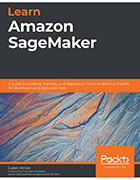AWS SageMaker training, making machine learning accessible
Making machine learning more accessible and helping developers with AWS SageMaker training is at the core of Julien Simon's book, 'Learn Amazon SageMaker.'
Making machine learning more accessible beyond data scientists is a top priority for many businesses, and it's also the focus of a new book from Julien Simon, global technical evangelist for AI and machine learning at AWS. Making AWS SageMaker more broadly usable has been a primary part of his role since joining the company five years ago, and now he has laid out his vision in Learn Amazon SageMaker. The book is aimed at developers and data scientists who are looking to gain a better grasp on the fundamentals of AWS SageMaker and machine learning as a whole.
In a Q&A here, Simon discussed the maturity of the field and some of the key functionalities in AWS SageMaker.
Editor's note: The following has been edited for clarity and length.
How difficult is it to keep up with the pace of the machine learning realm?
Julien Simon: When I started in this team, I was the developer advocate for France and we had, at the time, about 50 Amazon services. Right now, it's getting closer to 200. It's grown massively in five years. When I joined, you could have all the 50 Amazon services on one slide, and, now, we're getting to the point where it's difficult to just have all the machine learning services on one slide.
It's a challenge to keep up, but it's also part of my role to help developers out. You can't learn and know everything all the time, right? So, you have to say, 'What do I need right now, what matters most to me, to my company and to my own customers.'
There was little educational content to start with out there, but every roadblock that I've faced is probably a roadblock that thousands of other people have faced. My job is banging my head against the wall so that you don't have to. I try to figure it out for myself and then explain it in the simplest and clearest possible way.
What are some of the challenges that developers face when approaching machine learning?
Simon: The lack of beginner-oriented and developer-oriented resources. There's a ton of content out there and, it's not as true today as it was five years ago, but every time you would open a machine learning book or read machine learning blog posts, within a paragraph you'd be deep down in equations and stats and probabilities.
You're never going to get enough experts and machine learning Ph.D.s, so if we don't make it easier for the average developer -- somebody who's really good at writing application level code, but who doesn't have formal machine learning training -- then lots of companies won't be able to join the machine learning party.
Do you think the field has gotten significantly more mature since you've gotten into it?
Simon: It's still early days, but some bits have really made a lot of progress -- for example, training models. Now, you can just go and grab a pretrained model -- you know, in TensorFlow or PyTorch hubs -- deploy them in a few lines of code and start predicting within minutes. And these are trained and optimized by experts. So, there is a certain level of commoditization that has happened on models particularly.
But data science, in general, is still very much a manual process. AutoML is trying to improve things there, but data science still requires a lot of expertise. At the other end of the spectrum, model deployment and management, once in production, is in its early days as well. But I think we've proven that the technology can solve insanely complicated problems.
Click here to read Chapter 4 of Simon's book, Learning Amazon SageMaker.
 Click here to learn more
Click here to learn more





